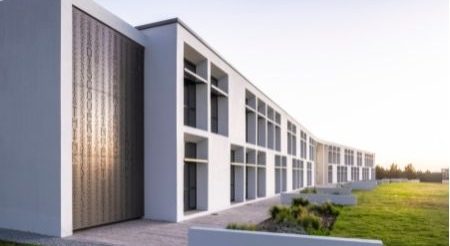An innovation centre for a progressive school

Parklands College, along with development partner Milnerton Estates, commissioned multidisciplinary design studio dhk Architects to tackle a new and challenging tech education project. The brief was to create a substantial addition to its existing campus, dedicated entirely to spaces that facilitate progressive teaching techniques and philosophies.
The project, Parklands College’s ‘Innovation Centre’ subsequently became the 2021 winner of the prestigious SAPOA (South African Property Owner’s Association) Awards in the ‘Other’ category.
“Over the past several years, schools around the world, including South Africa have begun to embrace new modes of learning. This shift has emerged as a result of technological advancements, new ways of accessing and disseminating information, as well as a pedagogical shift towards collaborative or blended learning” says Sarah Patterson, dhk’s project architect on a newly established Innovation Centre for Parklands College.
The college is located in Parklands, one of the west coast suburbs of Cape Town and is listed as an Apple Distinguished School, centres of leadership and educational excellence located around the world that demonstrate the tech giant’s vision for learning with technology.
A progressive approach
A key focus area involved creating spaces to facilitate group work and classes that combine science, technology, engineering and mathematics-based subjects with art-based subjects into creative problem-solving activities. Additionally, as a local leader in the emerging field of robotics, another focus area was on creating workshop-style learning spaces to facilitate soft entrepreneurial- and vocational-based skills training
According to the college, robotics creates an interest in Science, Technology, Engineering and Arts and Mathematics (STEAM) in learners from a young age. As such, Parklands College integrated LEGO Mechanics and LEGO Robotics as an addition to its subject offerings from an early phase of education..
Hence, themes of interconnectivity, transparency and movement were vital to the ethos of the centre.
When considering what sort of ‘spatial instruments’ could facilitate such new modes of learning and how they might deviate from traditional environments, the architects conducted a series of workshops with the college and professional team, testing a range of configurations which balanced the need for stimulating and physically connected spaces with the need for moments of quiet focus, or careful acoustic control; spaces that balance a sense of containment with a feeling of connectedness. The solution was ultimately found in clusters of interconnected spaces of varying sizes, often adjacent to or connected by circulation spaces, which have the opportunity to become recreational areas or extensions of the learning environment.
Two solid rectilinear wings separated by courtyards
Conceptually, the building was envisioned as two solid rectilinear wings separated by courtyards; the southern wing responding to the college’s quadrangle and the gently bending northern wing providing a distinctive, striking backdrop to the playing fields. The two wings are simultaneously split and bound together by a large, steel-and-glass double-volume recreational atrium aptly named ‘Grand Central’, which forms the nucleus of the building. Not only does the atrium serve as a central movement hub, but it is also used for activities such as informal gatherings, impromptu performances, self-study and immersive digital experiences.
Overall, the architectural design is contemporary and elegantly simple. It makes a distinct departure from the existing style of the campus buildings, yet remains sympathetic to the overall, orthogonal planning. The form of the building was strongly driven by optimising spatial relationships while adhering to the basic tenets of good environmental design, particularly internal environmental comfort.
Several playful details throughout the new building
Of interest to the casual eye are the several playful details throughout the new building. One is the distinctive, perforated aluminium screen which bathes the atrium in dappled light. The embedded pattern on the screen is a subtle reference to the concept of coding, where holes of different sizes create a sense of openness but also form vertical streams of light spots which reveal words reflecting the ethos of the building – ‘discover’ and ‘innovate’. Additionally, the DNA-inspired pendant light-fittings in the atrium remind learners of the human code within us.
About Us
Van Heerden Mays Publications cc T/A Media Xpose, a Level 2 BBBEE, was established in September 2010 with a 60% black ownership.
We specialize in magazine publishing, corporate branding, digital advertising, graphic design, print and sponsorships.
We are publishers of various print publications, which include the following titles: To Build, SA Building Review, Baby’s and Beyond , SA Business Integrator, SA Profile, Rove SA and Future SA.
, SA Business Integrator, SA Profile, Rove SA and Future SA.
We also offer customised designs for print of product catalogues, coffee table magazines, brochures, pamphlets, business cards, corporate invitations, creative design and more.
To provide clients with predictive, validated decision-making tools to optimise creative development, measure advertising effectiveness and maximise media planning for a better return on investment.
We believe in a simple philosophy. Education, information, and inspiration, which are the core reasons we are in business.
To supply printed information to our clients and readers, that will inspire and educate them.
To treat all clients as partners and to build feasible business relationships that benefits both parties.
We also aim to continue with our commitment towards excellence in exposure via our print and digital platforms.
Education, information and inspiration, are the core reasons we are in business.
The post An innovation centre for a progressive school appeared first on MediaXpose.
